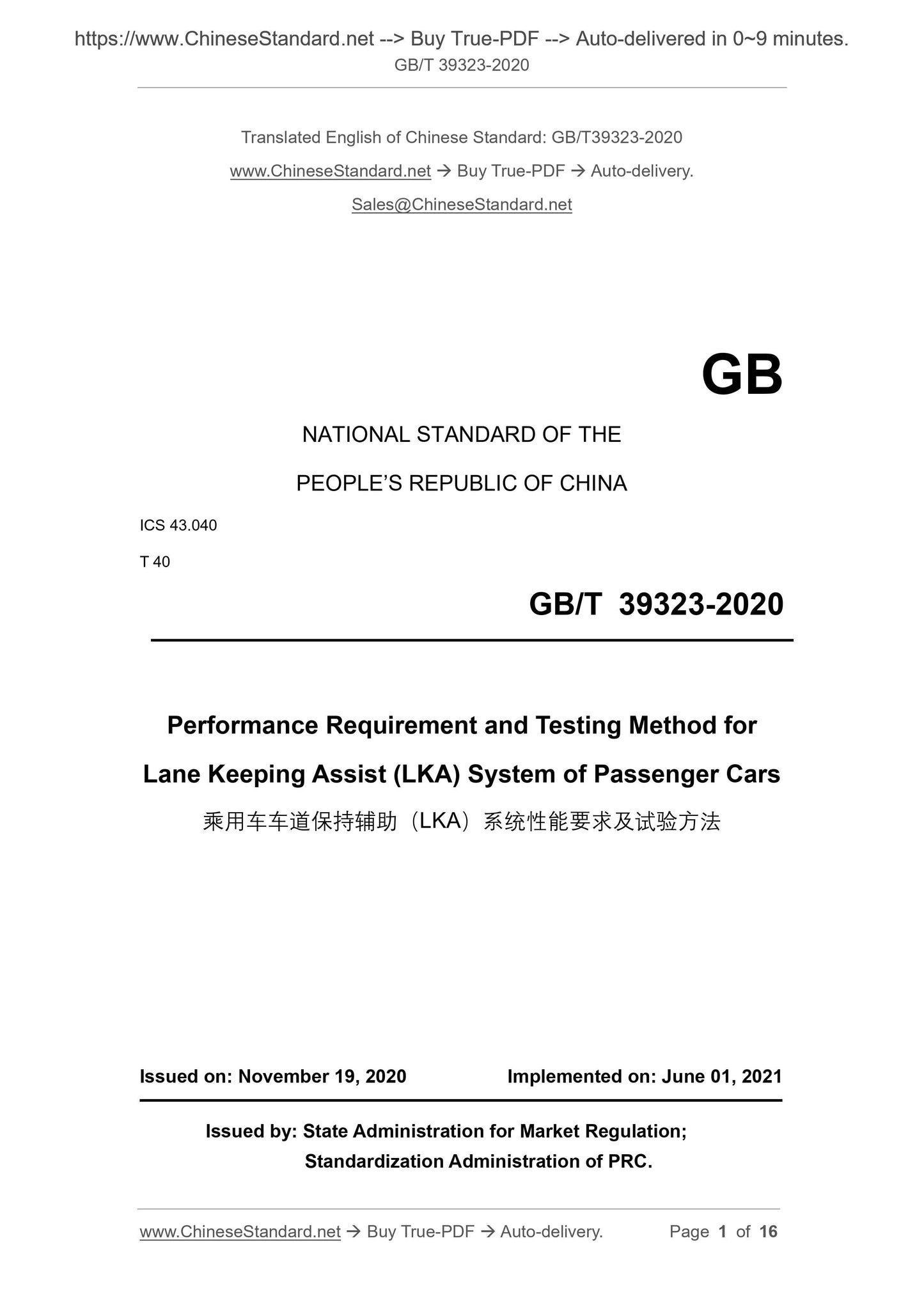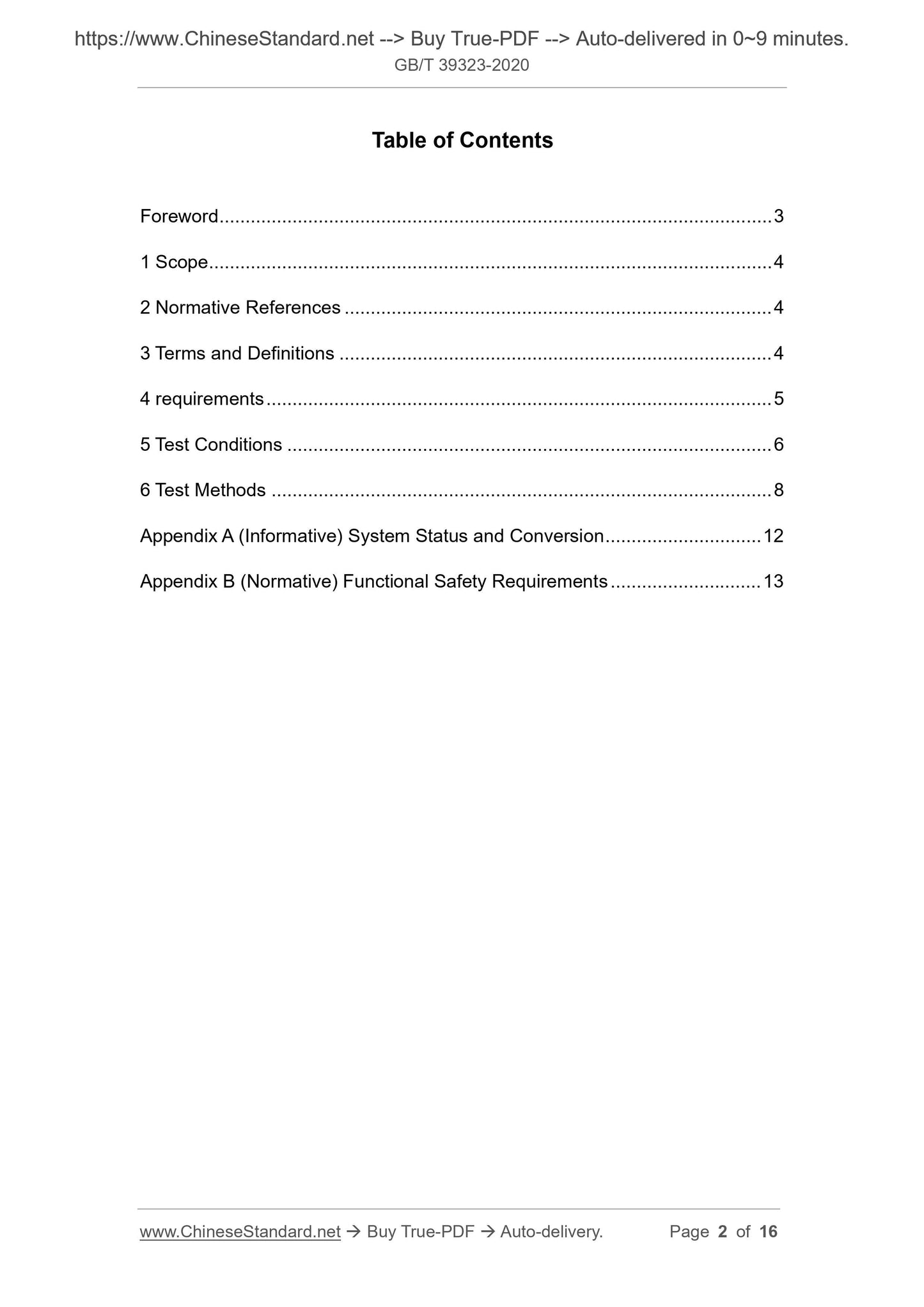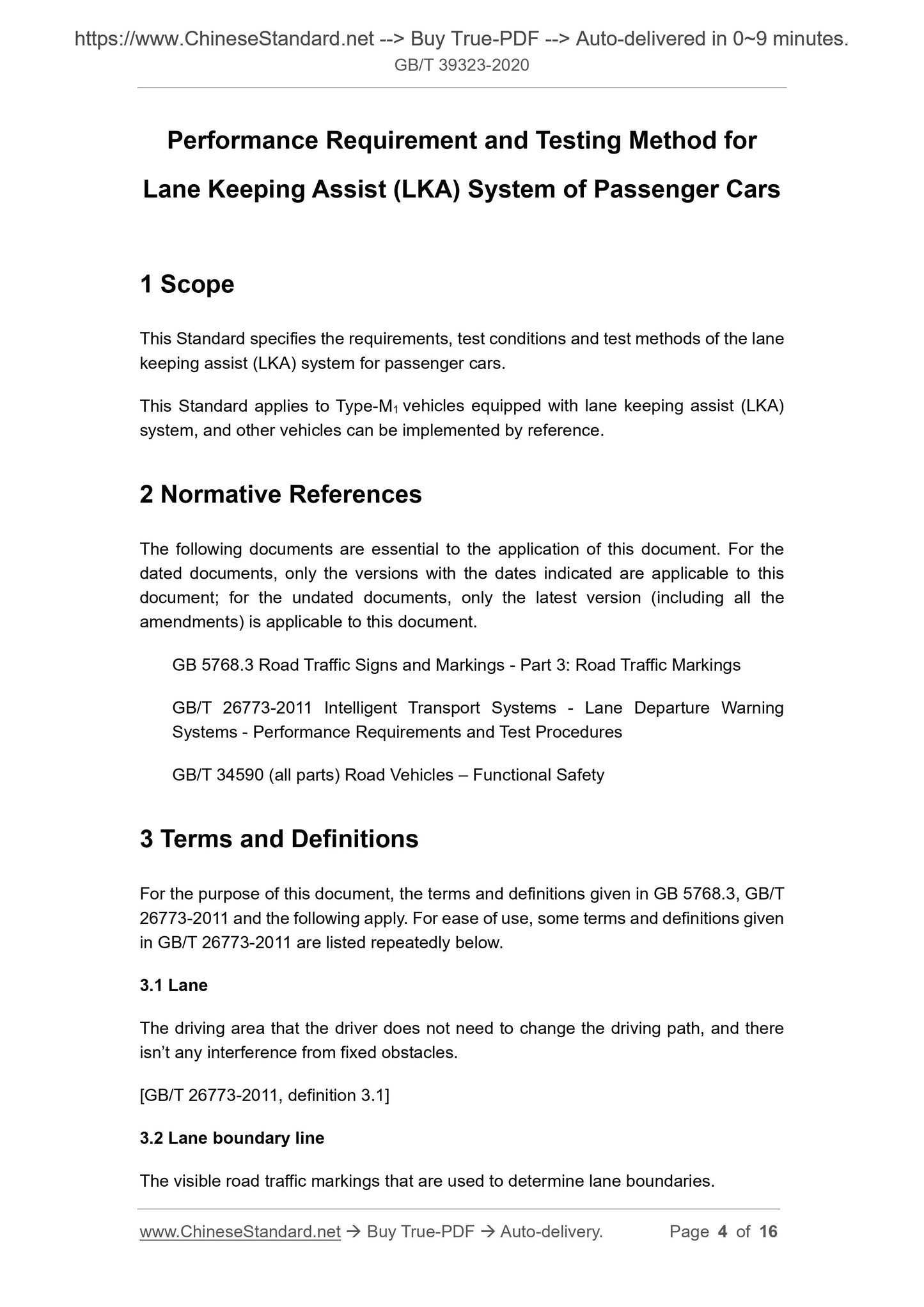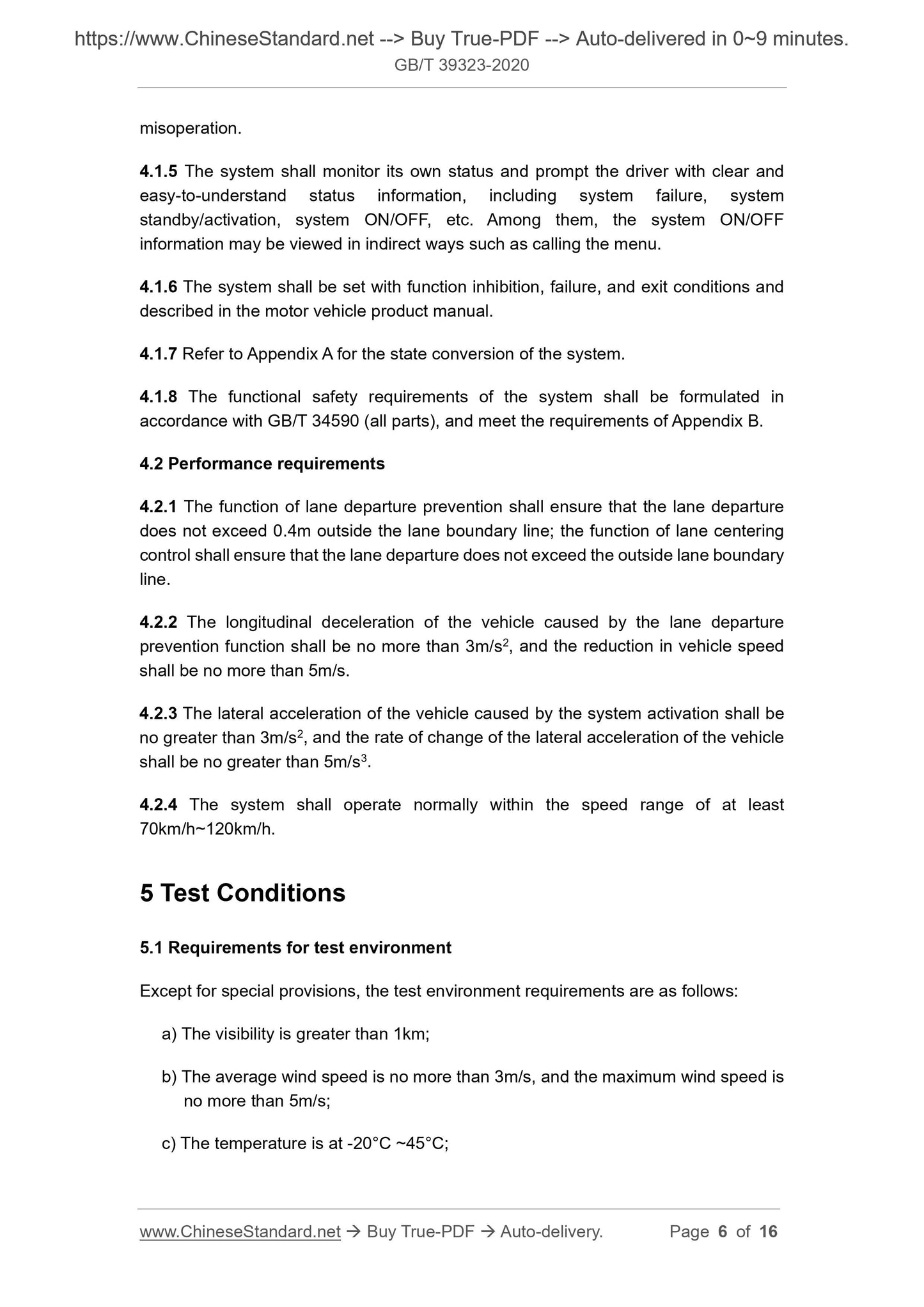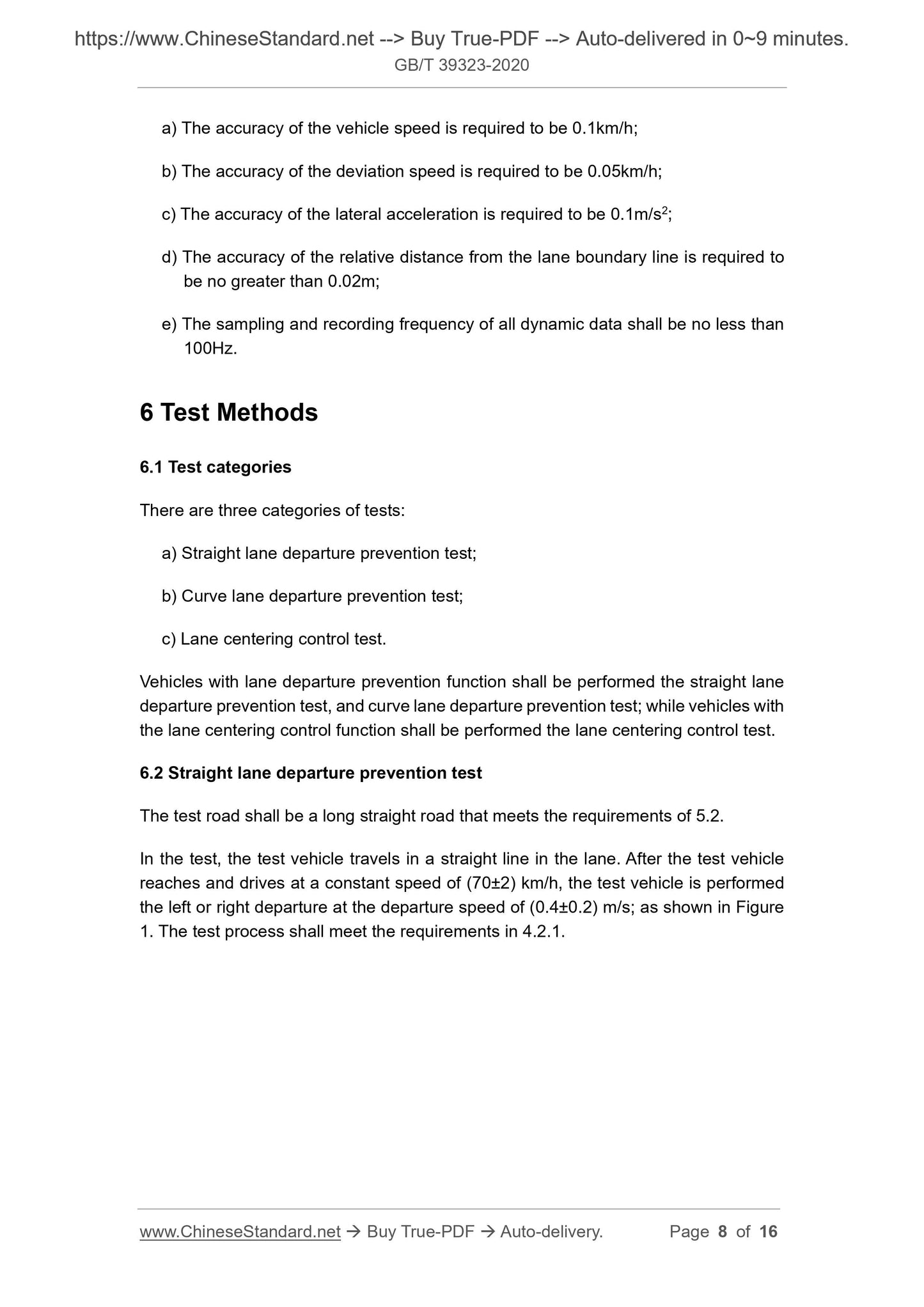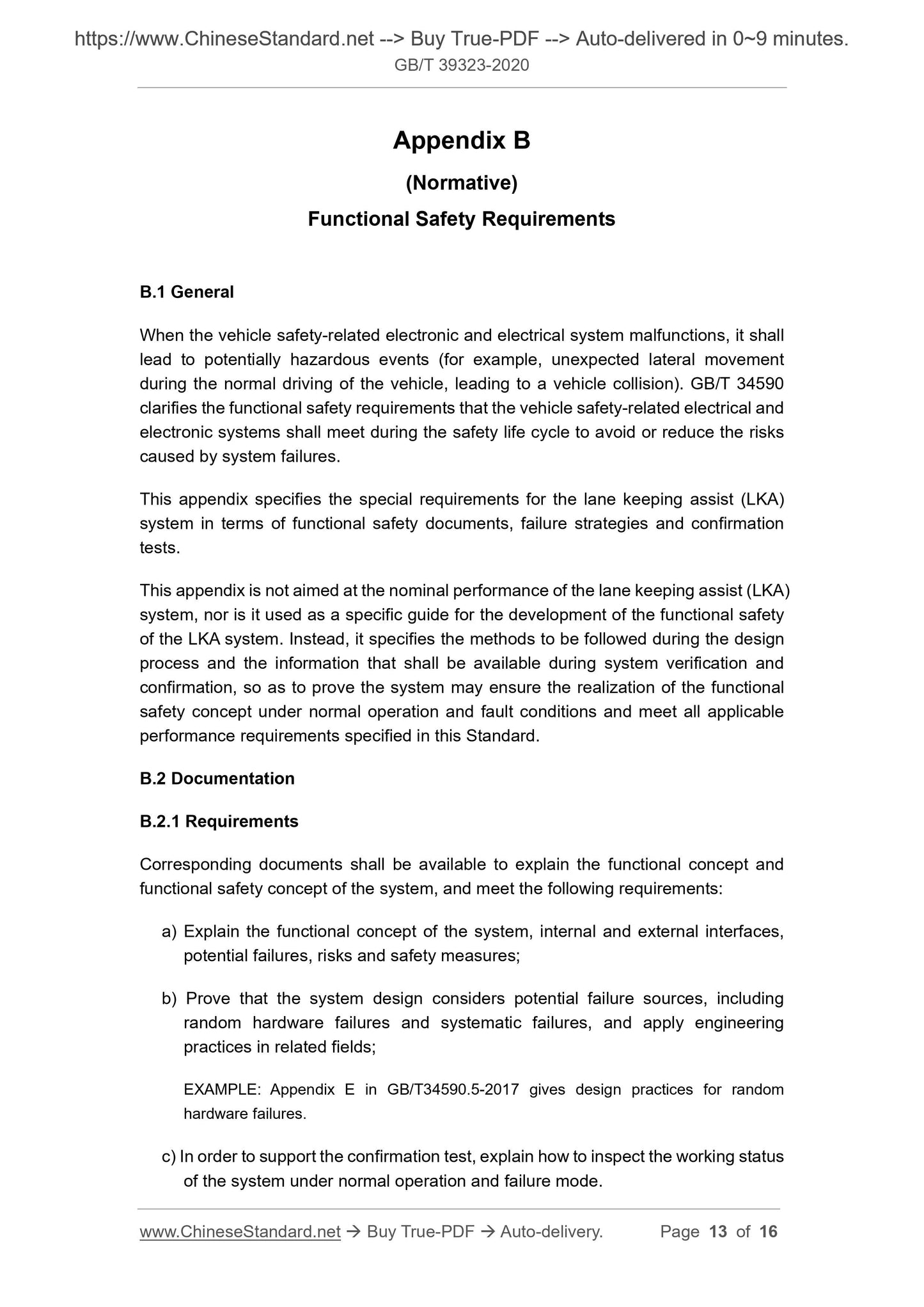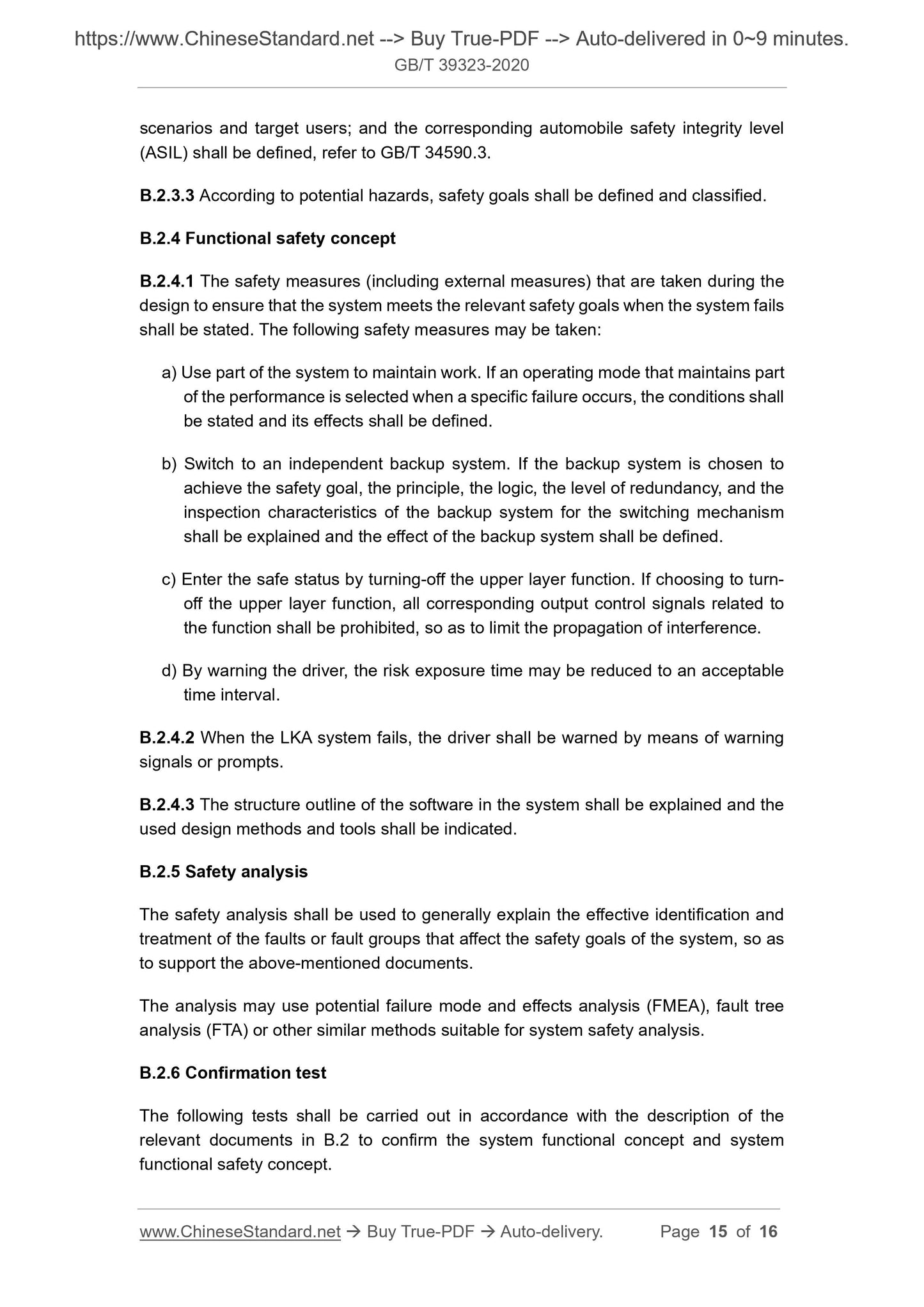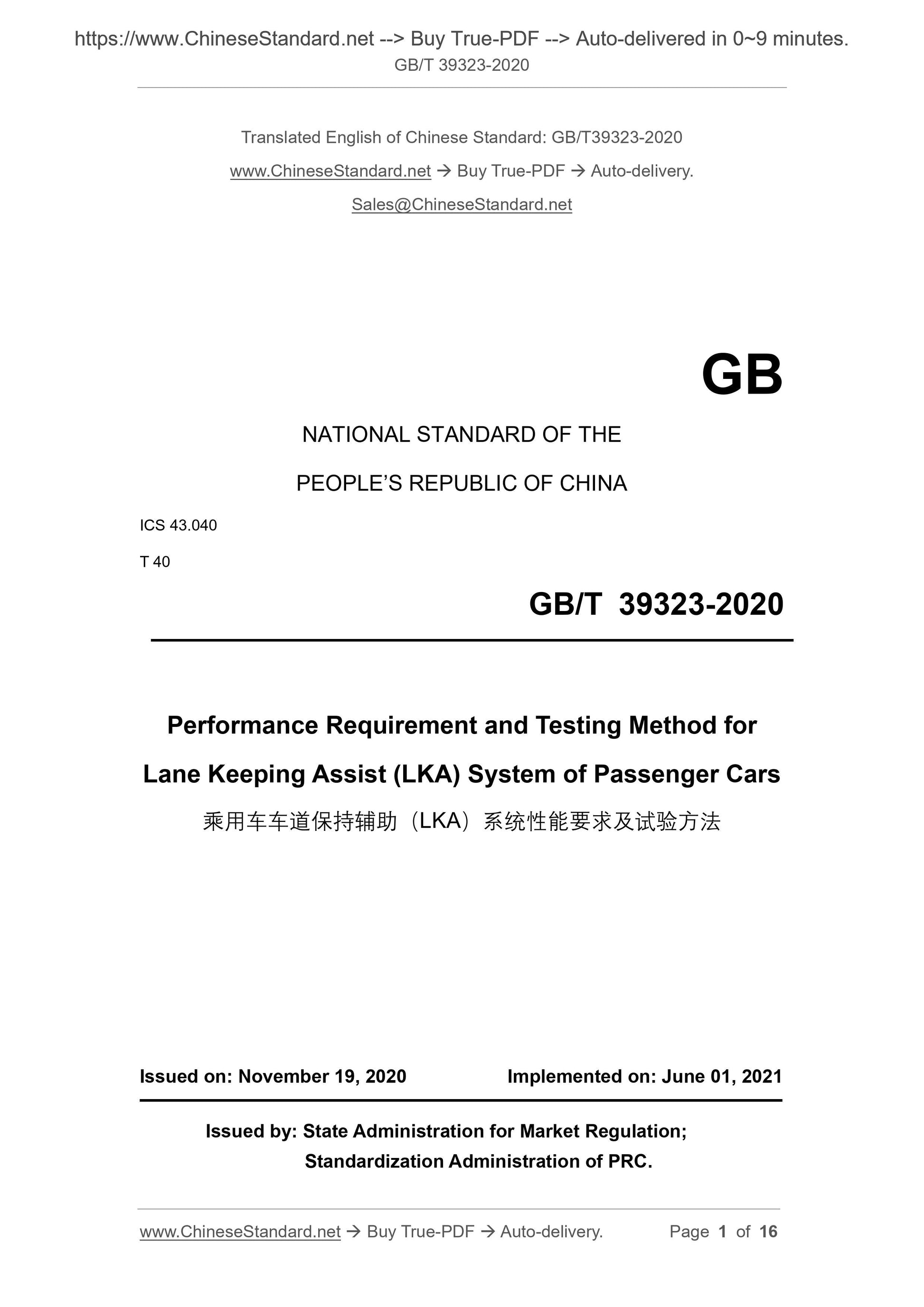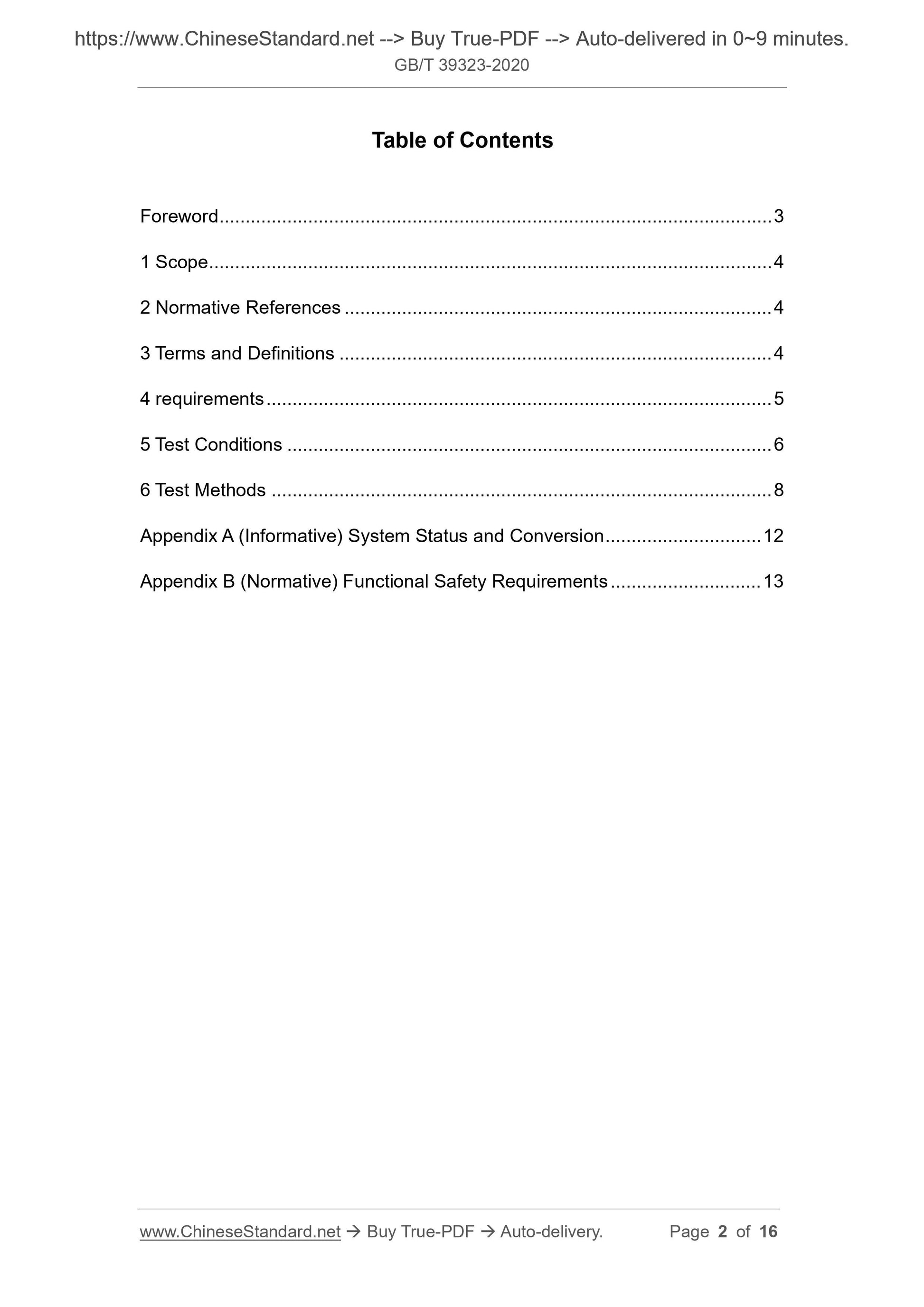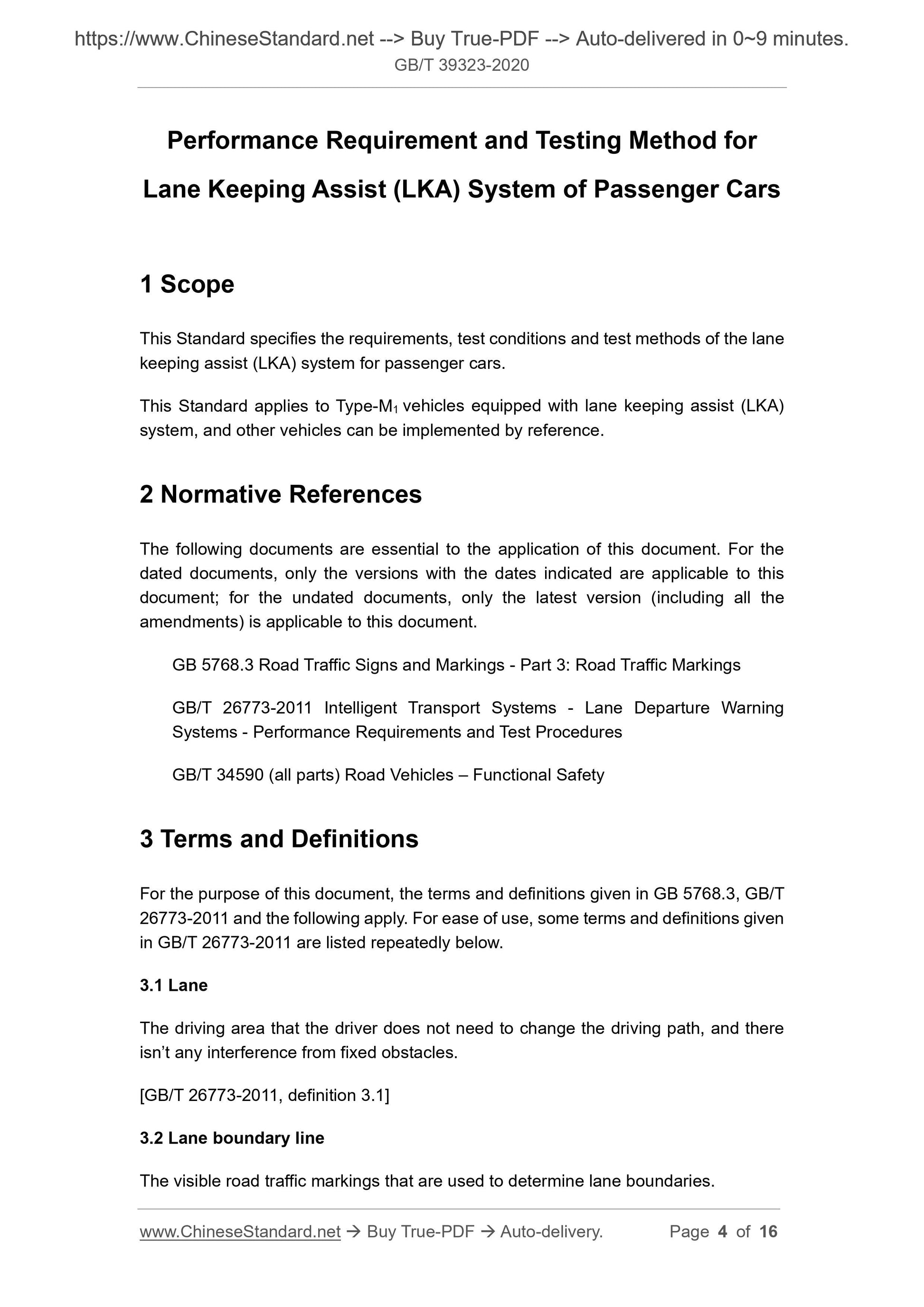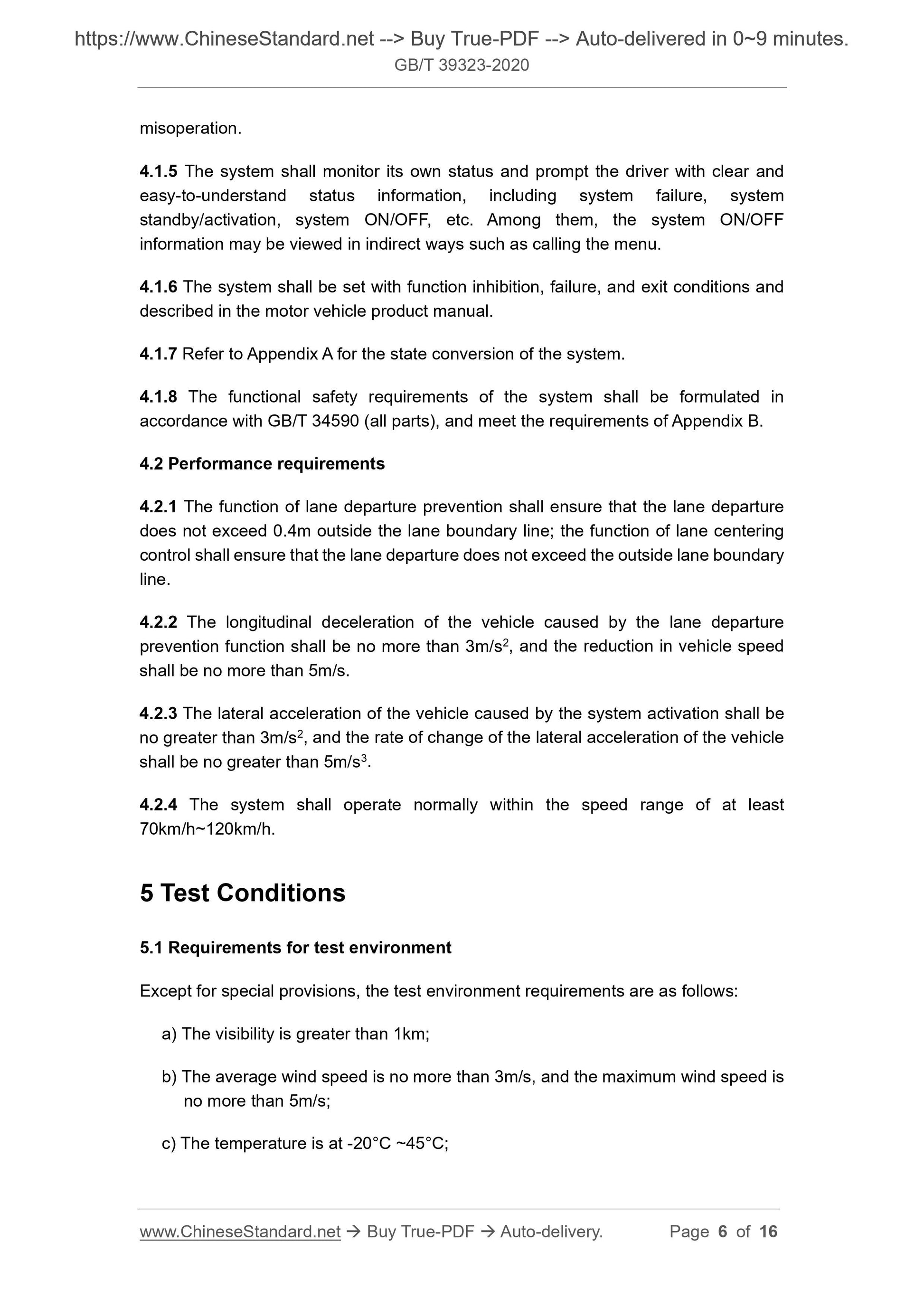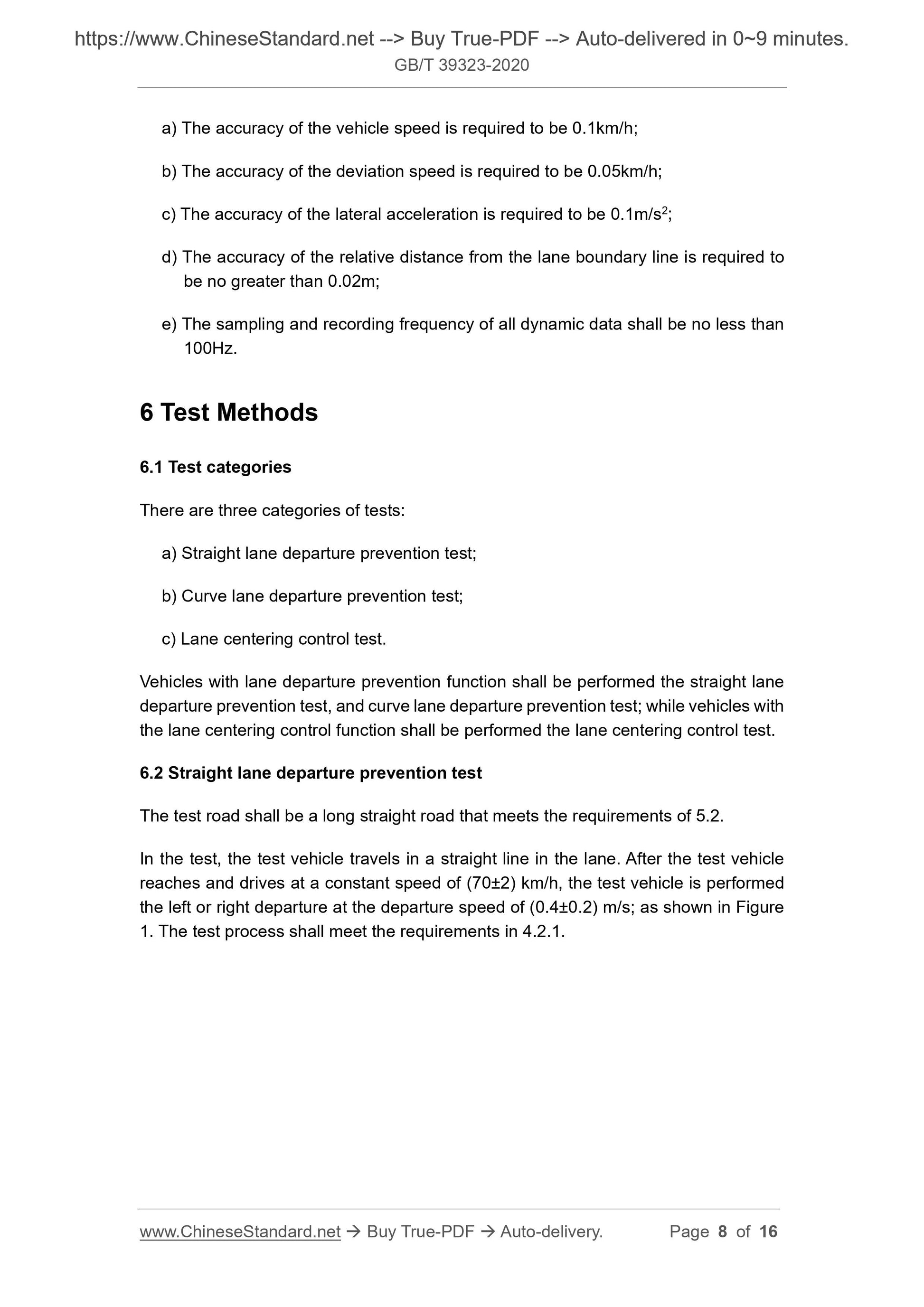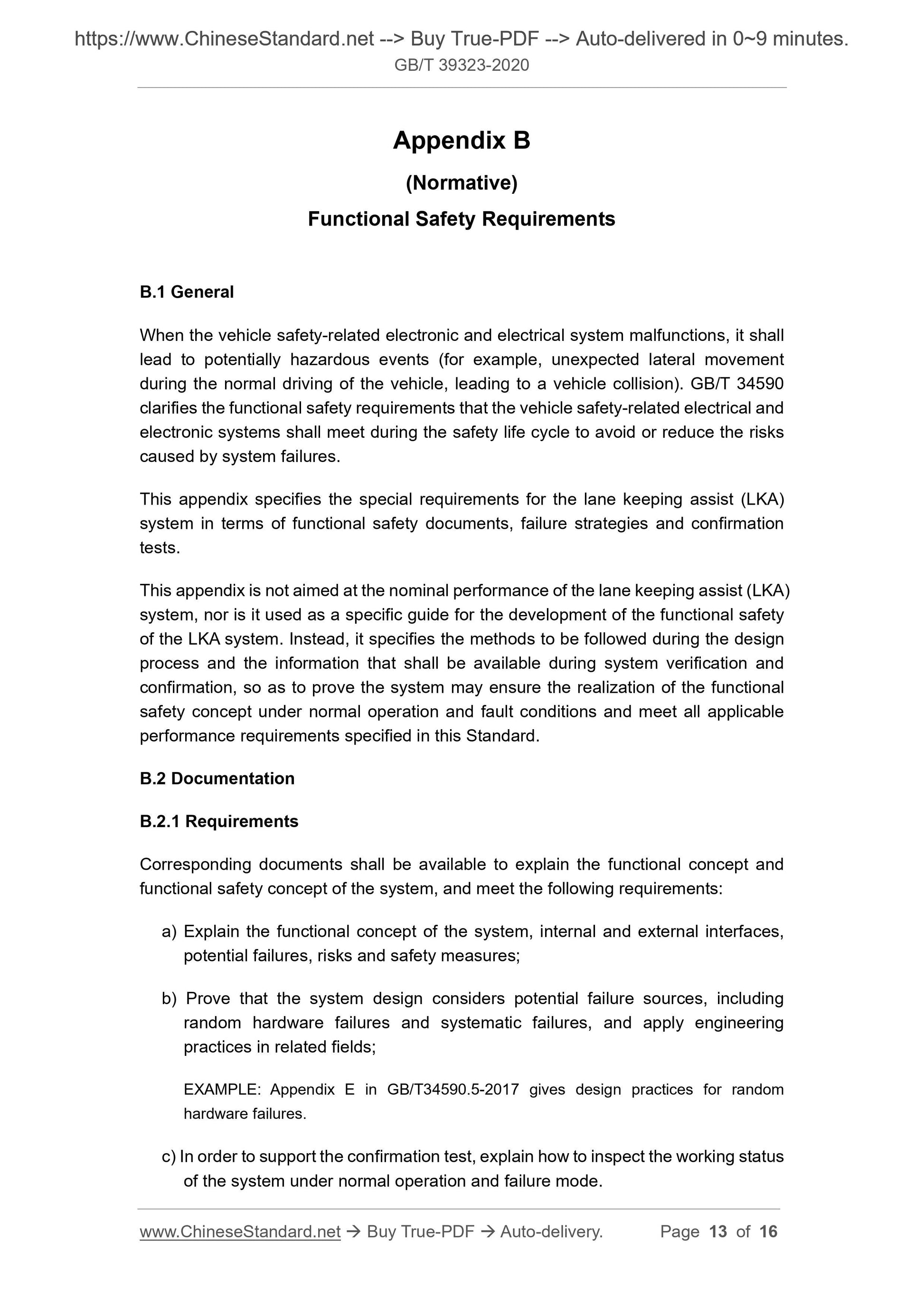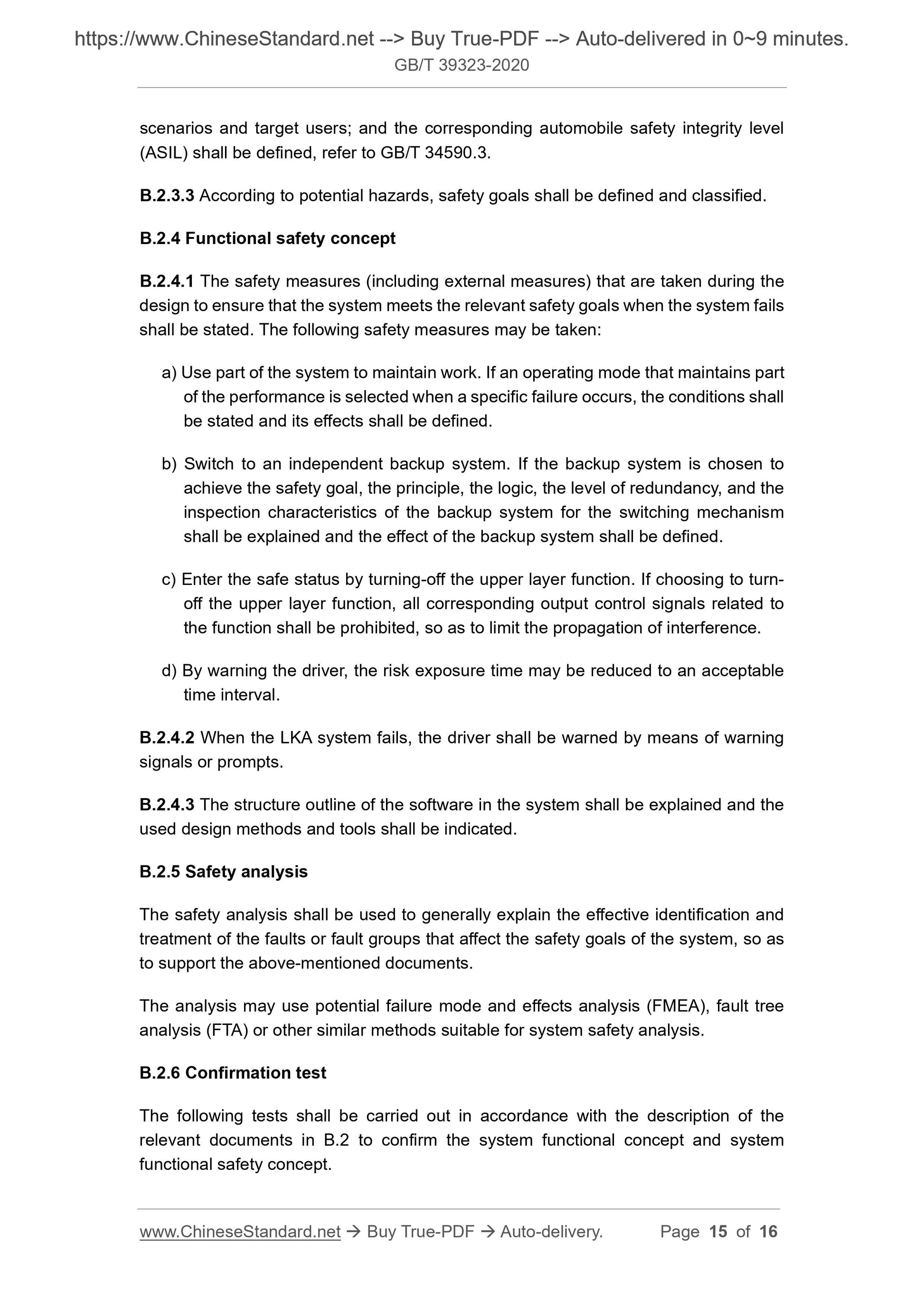1
/
of
7
www.ChineseStandard.us -- Field Test Asia Pte. Ltd.
GB/T 39323-2020 English PDF (GB/T39323-2020)
GB/T 39323-2020 English PDF (GB/T39323-2020)
Regular price
$205.00
Regular price
Sale price
$205.00
Unit price
/
per
Shipping calculated at checkout.
Couldn't load pickup availability
GB/T 39323-2020: Performance Requirement and Testing Method for Lane Keeping Assist (LKA) System of Passenger Cars
Delivery: 9 seconds. Download (& Email) true-PDF + Invoice.
Get Quotation: Click GB/T 39323-2020 (Self-service in 1-minute)
Historical versions (Master-website): GB/T 39323-2020
Preview True-PDF (Reload/Scroll-down if blank)
GB/T 39323-2020
GB
NATIONAL STANDARD OF THE
PEOPLE’S REPUBLIC OF CHINA
ICS 43.040
T 40
Performance Requirement and Testing Method for
Lane Keeping Assist (LKA) System of Passenger Cars
ISSUED ON: NOVEMBER 19, 2020
IMPLEMENTED ON: JUNE 01, 2021
Issued by: State Administration for Market Regulation;
Standardization Administration of PRC.
Table of Contents
Foreword ... 3
1 Scope ... 4
2 Normative References ... 4
3 Terms and Definitions ... 4
4 requirements ... 5
5 Test Conditions ... 6
6 Test Methods ... 8
Appendix A (Informative) System Status and Conversion ... 12
Appendix B (Normative) Functional Safety Requirements ... 13
Performance Requirement and Testing Method for
Lane Keeping Assist (LKA) System of Passenger Cars
1 Scope
This Standard specifies the requirements, test conditions and test methods of the lane
keeping assist (LKA) system for passenger cars.
This Standard applies to Type-M1 vehicles equipped with lane keeping assist (LKA)
system, and other vehicles can be implemented by reference.
2 Normative References
The following documents are essential to the application of this document. For the
dated documents, only the versions with the dates indicated are applicable to this
document; for the undated documents, only the latest version (including all the
amendments) is applicable to this document.
GB 5768.3 Road Traffic Signs and Markings - Part 3: Road Traffic Markings
GB/T 26773-2011 Intelligent Transport Systems - Lane Departure Warning
Systems - Performance Requirements and Test Procedures
GB/T 34590 (all parts) Road Vehicles – Functional Safety
3 Terms and Definitions
For the purpose of this document, the terms and definitions given in GB 5768.3, GB/T
26773-2011 and the following apply. For ease of use, some terms and definitions given
in GB/T 26773-2011 are listed repeatedly below.
3.1 Lane
The driving area that the driver does not need to change the driving path, and there
isn’t any interference from fixed obstacles.
[GB/T 26773-2011, definition 3.1]
3.2 Lane boundary line
The visible road traffic markings that are used to determine lane boundaries.
misoperation.
4.1.5 The system shall monitor its own status and prompt the driver with clear and
easy-to-understand status information, including system failure, system
standby/activation, system ON/OFF, etc. Among them, the system ON/OFF
information may be viewed in indirect ways such as calling the menu.
4.1.6 The system shall be set with function inhibition, failure, and exit conditions and
described in the motor vehicle product manual.
4.1.7 Refer to Appendix A for the state conversion of the system.
4.1.8 The functional safety requirements of the system shall be formulated in
accordance with GB/T 34590 (all parts), and meet the requirements of Appendix B.
4.2 Performance requirements
4.2.1 The function of lane departure prevention shall ensure that the lane departure
does not exceed 0.4m outside the lane boundary line; the function of lane centering
control shall ensure that the lane departure does not exceed the outside lane boundary
line.
4.2.2 The longitudinal deceleration of the vehicle caused by the lane departure
prevention function shall be no more than 3m/s2, and the reduction in vehicle speed
shall be no more than 5m/s.
4.2.3 The lateral acceleration of the vehicle caused by the system activation shall be
no greater than 3m/s2, and the rate of change of the lateral acceleration of the vehicle
shall be no greater than 5m/s3.
4.2.4 The system shall operate normally within the speed range of at least
70km/h~120km/h.
5 Test Conditions
5.1 Requirements for test environment
Except for special provisions, the test environment requirements are as follows:
a) The visibility is greater than 1km;
b) The average wind speed is no more than 3m/s, and the maximum wind speed is
no more than 5m/s;
c) The temperature is at -20°C ~45°C;
a) The accuracy of the vehicle speed is required to be 0.1km/h;
b) The accuracy of the deviation speed is required to be 0.05km/h;
c) The accuracy of the lateral acceleration is required to be 0.1m/s2;
d) The accuracy of the relative distance from the lane boundary line is required to
be no greater than 0.02m;
e) The sampling and recording frequency of all dynamic data shall be no less than
100Hz.
6 Test Methods
6.1 Test categories
There are three categories of tests:
a) Straight lane departure prevention test;
b) Curve lane departure prevention test;
c) Lane centering control test.
Vehicles with lane departure prevention function shall be performed the straight lane
departure prevention test, and curve lane departure prevention test; while vehicles with
the lane centering control function shall be performed the lane centering control test.
6.2 Straight lane departure prevention test
The test road shall be a long straight road that meets the requirements of 5.2.
In the test, the test vehicle travels in a straight line in the lane. After the test vehicle
reaches and drives at a constant speed of (70±2) km/h, the test vehicle is performed
the left or right departure at the departure speed of (0.4±0.2) m/s; as shown in Figure
1. The test process shall meet the requirements in 4.2.1.
Appendix B
(Normative)
Functional Safety Requirements
B.1 General
When the vehicle safety-related electronic and electrical system malfunctions, it shall
lead to potentially hazardous events (for example, unexpected lateral movement
during the normal driving of the vehicle, leading to a vehicle collision). GB/T 34590
clarifies the functional safety requirements that the vehicle safety-related electrical and
electronic systems shall meet during the safety life cycle to avoid or reduce the risks
caused by system failures.
This appendix specifies the special requirements for the lane keeping assist (LKA)
system in terms of functional safety documents, failure strategies and confirmation
tests.
This appendix is not aimed at the nominal performance of the lane keeping assist (LKA)
system, nor is it used as a specific guide for the development of the functional safety
of the LKA system. Instead, it specifies the methods to be followed during the design
process and the information that shall be available during system verification and
confirmation, so as to prove the system may ensure the realization of the functional
safety concept under normal operation and fault conditions and meet all applicable
performance requirements specified in this Standard.
B.2 Documentation
B.2.1 Requirements
Corresponding documents shall be available to explain the functional concept and
functional safety concept of the system, and meet the following requirements:
a) Explain the functional concept of the system, internal and external interfaces,
potential failures, risks and safety measures;
b) Prove that the system design considers potential failure sources, including
random hardware failures and systematic failures, and apply engineering
practices in related fields;
EXAMPLE: Appendix E in GB/T34590.5-2017 gives design practices for random
hardware failures.
c) In order to support the confirmation test, explain how to inspect the working status
of the system under normal operation and failure mode.
scenarios and target users; and the corresponding automobile safety integrity level
(ASIL) shall be defined, refer to GB/T 34590.3.
B.2.3.3 According to potential hazards, safety goals shall be defined and classified.
B.2.4 Functional safety concept
B.2.4.1 The safety measures (including external measures) that are taken during the
design to ensure that the system meets the relevant safety goals when the system fails
shall be stated. The following safety measures may be taken:
a) Use part of the system to maintain work. If an operating mode that maintains part
of the performance is selected when a specific failure occurs, the conditions shall
be stated and its effects shall be defined.
b) Switch to an independent backup system. If the backup system is chosen to
achieve the safety goal, the principle, the logic, the level of redundancy, and the
inspection characteristics of the backup system for the switching mechanism
shall be explained and the effect of the backup system shall be defined.
c) Enter the safe status by turning-off the upper layer function. If choosing to turn-
off the upper layer function, all corresponding output control signals related to
the function shall be prohibited, so as to limit the propagation of interference.
d) By warning the driver, the risk exposure time may be reduced to an acceptable
time interval.
B.2.4.2 When the LKA system fails, the driver shall be warned by means of warning
signals or prompts.
B.2.4.3 The structure outline of the software in the system shall be explained and the
used design methods and tools shall be indicated.
B.2.5 Safety analysis
The safety analysis shall be used to generally explain the effective identification and
treatment of the faults or fault groups that affect the safety goals of the system, so as
to support the above-mentioned documents.
The analysis may use potential failure mode and effects analysis (FMEA), fault tree
analysis (FTA) or other similar methods suitable for system safety analysis.
B.2.6 Confirmation test
The following tests shall be carried out in accordance with the description of the
relevant documents in B.2 to confirm the system functional concept and system
functional safety concept.
GB/T 39323-2020
GB
NATIONAL STANDARD OF THE
PEOPLE’S REPUBLIC OF CHINA
ICS 43.040
T 40
Performance Requirement and Testing Method for
Lane Keeping Assist (LKA) System of Passenger Cars
ISSUED ON: NOVEMBER 19, 2020
IMPLEMENTED ON: JUNE 01, 2021
Issued by: State Administration for Market Regulation;
Standardization Administration of PRC.
Table of Contents
Foreword ... 3
1 Scope ... 4
2 Normative References ... 4
3 Terms and Definitions ... 4
4 requirements ... 5
5 Test Conditions ... 6
6 Test Methods ... 8
Appendix A (Informative) System Status and Conversion ... 12
Appendix B (Normative) Functional Safety Requirements ... 13
Performance Requirement and Testing Method for
Lane Keeping Assist (LKA) System of Passenger Cars
1 Scope
This Standard specifies the requirements, test conditions and test methods of the lane
keeping assist (LKA) system for passenger cars.
This Standard applies to Type-M1 vehicles equipped with lane keeping assist (LKA)
system, and other vehicles can be implemented by reference.
2 Normative References
The following documents are essential to the application of this document. For the
dated documents, only the versions with the dates indicated are applicable to this
document; for the undated documents, only the latest version (including all the
amendments) is applicable to this document.
GB 5768.3 Road Traffic Signs and Markings - Part 3: Road Traffic Markings
GB/T 26773-2011 Intelligent Transport Systems - Lane Departure Warning
Systems - Performance Requirements and Test Procedures
GB/T 34590 (all parts) Road Vehicles – Functional Safety
3 Terms and Definitions
For the purpose of this document, the terms and definitions given in GB 5768.3, GB/T
26773-2011 and the following apply. For ease of use, some terms and definitions given
in GB/T 26773-2011 are listed repeatedly below.
3.1 Lane
The driving area that the driver does not need to change the driving path, and there
isn’t any interference from fixed obstacles.
[GB/T 26773-2011, definition 3.1]
3.2 Lane boundary line
The visible road traffic markings that are used to determine lane boundaries.
misoperation.
4.1.5 The system shall monitor its own status and prompt the driver with clear and
easy-to-understand status information, including system failure, system
standby/activation, system ON/OFF, etc. Among them, the system ON/OFF
information may be viewed in indirect ways such as calling the menu.
4.1.6 The system shall be set with function inhibition, failure, and exit conditions and
described in the motor vehicle product manual.
4.1.7 Refer to Appendix A for the state conversion of the system.
4.1.8 The functional safety requirements of the system shall be formulated in
accordance with GB/T 34590 (all parts), and meet the requirements of Appendix B.
4.2 Performance requirements
4.2.1 The function of lane departure prevention shall ensure that the lane departure
does not exceed 0.4m outside the lane boundary line; the function of lane centering
control shall ensure that the lane departure does not exceed the outside lane boundary
line.
4.2.2 The longitudinal deceleration of the vehicle caused by the lane departure
prevention function shall be no more than 3m/s2, and the reduction in vehicle speed
shall be no more than 5m/s.
4.2.3 The lateral acceleration of the vehicle caused by the system activation shall be
no greater than 3m/s2, and the rate of change of the lateral acceleration of the vehicle
shall be no greater than 5m/s3.
4.2.4 The system shall operate normally within the speed range of at least
70km/h~120km/h.
5 Test Conditions
5.1 Requirements for test environment
Except for special provisions, the test environment requirements are as follows:
a) The visibility is greater than 1km;
b) The average wind speed is no more than 3m/s, and the maximum wind speed is
no more than 5m/s;
c) The temperature is at -20°C ~45°C;
a) The accuracy of the vehicle speed is required to be 0.1km/h;
b) The accuracy of the deviation speed is required to be 0.05km/h;
c) The accuracy of the lateral acceleration is required to be 0.1m/s2;
d) The accuracy of the relative distance from the lane boundary line is required to
be no greater than 0.02m;
e) The sampling and recording frequency of all dynamic data shall be no less than
100Hz.
6 Test Methods
6.1 Test categories
There are three categories of tests:
a) Straight lan...
Delivery: 9 seconds. Download (& Email) true-PDF + Invoice.
Get Quotation: Click GB/T 39323-2020 (Self-service in 1-minute)
Historical versions (Master-website): GB/T 39323-2020
Preview True-PDF (Reload/Scroll-down if blank)
GB/T 39323-2020
GB
NATIONAL STANDARD OF THE
PEOPLE’S REPUBLIC OF CHINA
ICS 43.040
T 40
Performance Requirement and Testing Method for
Lane Keeping Assist (LKA) System of Passenger Cars
ISSUED ON: NOVEMBER 19, 2020
IMPLEMENTED ON: JUNE 01, 2021
Issued by: State Administration for Market Regulation;
Standardization Administration of PRC.
Table of Contents
Foreword ... 3
1 Scope ... 4
2 Normative References ... 4
3 Terms and Definitions ... 4
4 requirements ... 5
5 Test Conditions ... 6
6 Test Methods ... 8
Appendix A (Informative) System Status and Conversion ... 12
Appendix B (Normative) Functional Safety Requirements ... 13
Performance Requirement and Testing Method for
Lane Keeping Assist (LKA) System of Passenger Cars
1 Scope
This Standard specifies the requirements, test conditions and test methods of the lane
keeping assist (LKA) system for passenger cars.
This Standard applies to Type-M1 vehicles equipped with lane keeping assist (LKA)
system, and other vehicles can be implemented by reference.
2 Normative References
The following documents are essential to the application of this document. For the
dated documents, only the versions with the dates indicated are applicable to this
document; for the undated documents, only the latest version (including all the
amendments) is applicable to this document.
GB 5768.3 Road Traffic Signs and Markings - Part 3: Road Traffic Markings
GB/T 26773-2011 Intelligent Transport Systems - Lane Departure Warning
Systems - Performance Requirements and Test Procedures
GB/T 34590 (all parts) Road Vehicles – Functional Safety
3 Terms and Definitions
For the purpose of this document, the terms and definitions given in GB 5768.3, GB/T
26773-2011 and the following apply. For ease of use, some terms and definitions given
in GB/T 26773-2011 are listed repeatedly below.
3.1 Lane
The driving area that the driver does not need to change the driving path, and there
isn’t any interference from fixed obstacles.
[GB/T 26773-2011, definition 3.1]
3.2 Lane boundary line
The visible road traffic markings that are used to determine lane boundaries.
misoperation.
4.1.5 The system shall monitor its own status and prompt the driver with clear and
easy-to-understand status information, including system failure, system
standby/activation, system ON/OFF, etc. Among them, the system ON/OFF
information may be viewed in indirect ways such as calling the menu.
4.1.6 The system shall be set with function inhibition, failure, and exit conditions and
described in the motor vehicle product manual.
4.1.7 Refer to Appendix A for the state conversion of the system.
4.1.8 The functional safety requirements of the system shall be formulated in
accordance with GB/T 34590 (all parts), and meet the requirements of Appendix B.
4.2 Performance requirements
4.2.1 The function of lane departure prevention shall ensure that the lane departure
does not exceed 0.4m outside the lane boundary line; the function of lane centering
control shall ensure that the lane departure does not exceed the outside lane boundary
line.
4.2.2 The longitudinal deceleration of the vehicle caused by the lane departure
prevention function shall be no more than 3m/s2, and the reduction in vehicle speed
shall be no more than 5m/s.
4.2.3 The lateral acceleration of the vehicle caused by the system activation shall be
no greater than 3m/s2, and the rate of change of the lateral acceleration of the vehicle
shall be no greater than 5m/s3.
4.2.4 The system shall operate normally within the speed range of at least
70km/h~120km/h.
5 Test Conditions
5.1 Requirements for test environment
Except for special provisions, the test environment requirements are as follows:
a) The visibility is greater than 1km;
b) The average wind speed is no more than 3m/s, and the maximum wind speed is
no more than 5m/s;
c) The temperature is at -20°C ~45°C;
a) The accuracy of the vehicle speed is required to be 0.1km/h;
b) The accuracy of the deviation speed is required to be 0.05km/h;
c) The accuracy of the lateral acceleration is required to be 0.1m/s2;
d) The accuracy of the relative distance from the lane boundary line is required to
be no greater than 0.02m;
e) The sampling and recording frequency of all dynamic data shall be no less than
100Hz.
6 Test Methods
6.1 Test categories
There are three categories of tests:
a) Straight lane departure prevention test;
b) Curve lane departure prevention test;
c) Lane centering control test.
Vehicles with lane departure prevention function shall be performed the straight lane
departure prevention test, and curve lane departure prevention test; while vehicles with
the lane centering control function shall be performed the lane centering control test.
6.2 Straight lane departure prevention test
The test road shall be a long straight road that meets the requirements of 5.2.
In the test, the test vehicle travels in a straight line in the lane. After the test vehicle
reaches and drives at a constant speed of (70±2) km/h, the test vehicle is performed
the left or right departure at the departure speed of (0.4±0.2) m/s; as shown in Figure
1. The test process shall meet the requirements in 4.2.1.
Appendix B
(Normative)
Functional Safety Requirements
B.1 General
When the vehicle safety-related electronic and electrical system malfunctions, it shall
lead to potentially hazardous events (for example, unexpected lateral movement
during the normal driving of the vehicle, leading to a vehicle collision). GB/T 34590
clarifies the functional safety requirements that the vehicle safety-related electrical and
electronic systems shall meet during the safety life cycle to avoid or reduce the risks
caused by system failures.
This appendix specifies the special requirements for the lane keeping assist (LKA)
system in terms of functional safety documents, failure strategies and confirmation
tests.
This appendix is not aimed at the nominal performance of the lane keeping assist (LKA)
system, nor is it used as a specific guide for the development of the functional safety
of the LKA system. Instead, it specifies the methods to be followed during the design
process and the information that shall be available during system verification and
confirmation, so as to prove the system may ensure the realization of the functional
safety concept under normal operation and fault conditions and meet all applicable
performance requirements specified in this Standard.
B.2 Documentation
B.2.1 Requirements
Corresponding documents shall be available to explain the functional concept and
functional safety concept of the system, and meet the following requirements:
a) Explain the functional concept of the system, internal and external interfaces,
potential failures, risks and safety measures;
b) Prove that the system design considers potential failure sources, including
random hardware failures and systematic failures, and apply engineering
practices in related fields;
EXAMPLE: Appendix E in GB/T34590.5-2017 gives design practices for random
hardware failures.
c) In order to support the confirmation test, explain how to inspect the working status
of the system under normal operation and failure mode.
scenarios and target users; and the corresponding automobile safety integrity level
(ASIL) shall be defined, refer to GB/T 34590.3.
B.2.3.3 According to potential hazards, safety goals shall be defined and classified.
B.2.4 Functional safety concept
B.2.4.1 The safety measures (including external measures) that are taken during the
design to ensure that the system meets the relevant safety goals when the system fails
shall be stated. The following safety measures may be taken:
a) Use part of the system to maintain work. If an operating mode that maintains part
of the performance is selected when a specific failure occurs, the conditions shall
be stated and its effects shall be defined.
b) Switch to an independent backup system. If the backup system is chosen to
achieve the safety goal, the principle, the logic, the level of redundancy, and the
inspection characteristics of the backup system for the switching mechanism
shall be explained and the effect of the backup system shall be defined.
c) Enter the safe status by turning-off the upper layer function. If choosing to turn-
off the upper layer function, all corresponding output control signals related to
the function shall be prohibited, so as to limit the propagation of interference.
d) By warning the driver, the risk exposure time may be reduced to an acceptable
time interval.
B.2.4.2 When the LKA system fails, the driver shall be warned by means of warning
signals or prompts.
B.2.4.3 The structure outline of the software in the system shall be explained and the
used design methods and tools shall be indicated.
B.2.5 Safety analysis
The safety analysis shall be used to generally explain the effective identification and
treatment of the faults or fault groups that affect the safety goals of the system, so as
to support the above-mentioned documents.
The analysis may use potential failure mode and effects analysis (FMEA), fault tree
analysis (FTA) or other similar methods suitable for system safety analysis.
B.2.6 Confirmation test
The following tests shall be carried out in accordance with the description of the
relevant documents in B.2 to confirm the system functional concept and system
functional safety concept.
GB/T 39323-2020
GB
NATIONAL STANDARD OF THE
PEOPLE’S REPUBLIC OF CHINA
ICS 43.040
T 40
Performance Requirement and Testing Method for
Lane Keeping Assist (LKA) System of Passenger Cars
ISSUED ON: NOVEMBER 19, 2020
IMPLEMENTED ON: JUNE 01, 2021
Issued by: State Administration for Market Regulation;
Standardization Administration of PRC.
Table of Contents
Foreword ... 3
1 Scope ... 4
2 Normative References ... 4
3 Terms and Definitions ... 4
4 requirements ... 5
5 Test Conditions ... 6
6 Test Methods ... 8
Appendix A (Informative) System Status and Conversion ... 12
Appendix B (Normative) Functional Safety Requirements ... 13
Performance Requirement and Testing Method for
Lane Keeping Assist (LKA) System of Passenger Cars
1 Scope
This Standard specifies the requirements, test conditions and test methods of the lane
keeping assist (LKA) system for passenger cars.
This Standard applies to Type-M1 vehicles equipped with lane keeping assist (LKA)
system, and other vehicles can be implemented by reference.
2 Normative References
The following documents are essential to the application of this document. For the
dated documents, only the versions with the dates indicated are applicable to this
document; for the undated documents, only the latest version (including all the
amendments) is applicable to this document.
GB 5768.3 Road Traffic Signs and Markings - Part 3: Road Traffic Markings
GB/T 26773-2011 Intelligent Transport Systems - Lane Departure Warning
Systems - Performance Requirements and Test Procedures
GB/T 34590 (all parts) Road Vehicles – Functional Safety
3 Terms and Definitions
For the purpose of this document, the terms and definitions given in GB 5768.3, GB/T
26773-2011 and the following apply. For ease of use, some terms and definitions given
in GB/T 26773-2011 are listed repeatedly below.
3.1 Lane
The driving area that the driver does not need to change the driving path, and there
isn’t any interference from fixed obstacles.
[GB/T 26773-2011, definition 3.1]
3.2 Lane boundary line
The visible road traffic markings that are used to determine lane boundaries.
misoperation.
4.1.5 The system shall monitor its own status and prompt the driver with clear and
easy-to-understand status information, including system failure, system
standby/activation, system ON/OFF, etc. Among them, the system ON/OFF
information may be viewed in indirect ways such as calling the menu.
4.1.6 The system shall be set with function inhibition, failure, and exit conditions and
described in the motor vehicle product manual.
4.1.7 Refer to Appendix A for the state conversion of the system.
4.1.8 The functional safety requirements of the system shall be formulated in
accordance with GB/T 34590 (all parts), and meet the requirements of Appendix B.
4.2 Performance requirements
4.2.1 The function of lane departure prevention shall ensure that the lane departure
does not exceed 0.4m outside the lane boundary line; the function of lane centering
control shall ensure that the lane departure does not exceed the outside lane boundary
line.
4.2.2 The longitudinal deceleration of the vehicle caused by the lane departure
prevention function shall be no more than 3m/s2, and the reduction in vehicle speed
shall be no more than 5m/s.
4.2.3 The lateral acceleration of the vehicle caused by the system activation shall be
no greater than 3m/s2, and the rate of change of the lateral acceleration of the vehicle
shall be no greater than 5m/s3.
4.2.4 The system shall operate normally within the speed range of at least
70km/h~120km/h.
5 Test Conditions
5.1 Requirements for test environment
Except for special provisions, the test environment requirements are as follows:
a) The visibility is greater than 1km;
b) The average wind speed is no more than 3m/s, and the maximum wind speed is
no more than 5m/s;
c) The temperature is at -20°C ~45°C;
a) The accuracy of the vehicle speed is required to be 0.1km/h;
b) The accuracy of the deviation speed is required to be 0.05km/h;
c) The accuracy of the lateral acceleration is required to be 0.1m/s2;
d) The accuracy of the relative distance from the lane boundary line is required to
be no greater than 0.02m;
e) The sampling and recording frequency of all dynamic data shall be no less than
100Hz.
6 Test Methods
6.1 Test categories
There are three categories of tests:
a) Straight lan...
Share
